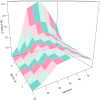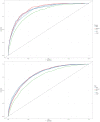The newly proposed Metabolic Score for Visceral Fat is a reliable tool for identifying non-alcoholic fatty liver disease, requiring attention to age-specific effects in both sexes
- PMID: 38089634
- PMCID: PMC10711077
- DOI: 10.3389/fendo.2023.1281524
The newly proposed Metabolic Score for Visceral Fat is a reliable tool for identifying non-alcoholic fatty liver disease, requiring attention to age-specific effects in both sexes
Abstract
Objective: The newly proposed Metabolic Visceral Fat Score (METS-VF) is considered a more effective measure for visceral adipose tissue (VAT) than other obesity indicators. This study aimed to reveal the association between METS-VF and non-alcoholic fatty liver disease (NAFLD), and its variations across age groups within both sexes.
Methods: Data from 14,251 medical examiners in the NAGALA project were employed in this study. 3D fitted surface plots were constructed based on multivariate logistic regression models to visualize the isolated and combined effects of aging and METS-VF on NAFLD. Receiver operating characteristic curve (ROC) analysis was conducted to compare the diagnostic performance of METS-VF with other VAT surrogate markers in predicting NAFLD.
Results: The results of multivariate logistic regression analysis showed that each unit increase in METS-VF was independently associated with a 333% and 312% increase in the odds of NAFLD in males and females, respectively. Additionally, the 3D fitted surface plot showed that age significantly influenced the association between METS-VF and the odds of NAFLD in both sexes, as follows: (i) In males, when METS-VF was less than 6.2, the METS-VF-related odds of NAFLD increased gradually with age in the 20-45 age group, reached a plateau in the 45-65 age group, and then decreased in the group above 65 years old; however, when male METS-VF exceeded 6.2, aging and METS-VF combined to further increase the odds of NAFLD in all age groups, particularly in the 45-65 age group. (ii) In females, aging seemed to reduce METS-VF-related odds of NAFLD in the 18-40 age group, but significantly increased it in the 40-60 age group, particularly for those with higher METS-VF levels. Further ROC analysis revealed that compared to other VAT surrogate markers, METS-VF showed the highest diagnostic accuracy for NAFLD in females, especially in those under 45 years of age [area under the curve (AUC) = 0.9256].
Conclusions: This study firstly revealed a significant positive correlation between METS-VF and the odds of NAFLD, with METS-VF surpassing other VAT surrogate markers in NAFLD diagnosis. Moreover, age significantly influenced the METS-VF-related odds of NAFLD and METS-VF's diagnostic efficacy for NAFLD in both sexes.
Keywords: METS-VF; Metabolic Visceral Fat Score; NAFLD; sex; visceral adipose tissue.
Copyright © 2023 Kuang, Qiu, Li, Hu, Zhang, Sheng and Zou.
Conflict of interest statement
The authors declare that the research was conducted in the absence of any commercial or financial relationships that could be construed as a potential conflict of interest.
Figures




Similar articles
-
Association of metabolic evaluation of visceral fat score with nonalcoholic fatty liver disease and liver fibrosis: A cross-sectional study based on NHANES.Medicine (Baltimore). 2025 Apr 25;104(17):e42213. doi: 10.1097/MD.0000000000042213. Medicine (Baltimore). 2025. PMID: 40295270 Free PMC article.
-
Assessing the usefulness of a newly proposed metabolic score for visceral fat in predicting future diabetes: results from the NAGALA cohort study.Front Endocrinol (Lausanne). 2023 Jul 19;14:1172323. doi: 10.3389/fendo.2023.1172323. eCollection 2023. Front Endocrinol (Lausanne). 2023. PMID: 37538796 Free PMC article.
-
Visceral and subcutaneous abdominal fat is associated with non-alcoholic fatty liver disease while augmenting Metabolic Syndrome's effect on non-alcoholic fatty liver disease: A cross-sectional study of NHANES 2017-2018.PLoS One. 2024 Feb 23;19(2):e0298662. doi: 10.1371/journal.pone.0298662. eCollection 2024. PLoS One. 2024. PMID: 38394065 Free PMC article.
-
Visceral adiposity and inflammatory bowel disease.Int J Colorectal Dis. 2021 Nov;36(11):2305-2319. doi: 10.1007/s00384-021-03968-w. Epub 2021 Jun 9. Int J Colorectal Dis. 2021. PMID: 34104989 Review.
-
Association of Serum Bilirubin With Metabolic Syndrome and Non-Alcoholic Fatty Liver Disease: A Systematic Review and Meta-Analysis.Front Endocrinol (Lausanne). 2022 Jul 20;13:869579. doi: 10.3389/fendo.2022.869579. eCollection 2022. Front Endocrinol (Lausanne). 2022. PMID: 35937795 Free PMC article.
Cited by
-
Association between metabolic score of visceral fat and all-cause mortality among individuals with metabolic dysfunction-associated steatotic liver disease: a follow-up study based on NHANES III (1988-1994).Diabetol Metab Syndr. 2025 Jul 30;17(1):302. doi: 10.1186/s13098-025-01864-9. Diabetol Metab Syndr. 2025. PMID: 40739243 Free PMC article.
-
Association between metabolic score for visceral fat and psoriasis: findings from NHANES.Eur J Med Res. 2025 Aug 12;30(1):739. doi: 10.1186/s40001-025-03002-7. Eur J Med Res. 2025. PMID: 40796893 Free PMC article.
-
Association between metabolic visceral fat score and left ventricular hypertrophy in individuals with type 2 diabetes.Diabetol Metab Syndr. 2025 Mar 6;17(1):81. doi: 10.1186/s13098-025-01648-1. Diabetol Metab Syndr. 2025. PMID: 40050939 Free PMC article.
-
Visceral Adiposity, Anthropometric and Liver Function Indexes for Identifying Metabolic Dysfunction Associated Steatotic Liver Disease (MASLD) in Adolescents with Obesity: Which Performs Better?J Clin Med. 2025 Mar 19;14(6):2085. doi: 10.3390/jcm14062085. J Clin Med. 2025. PMID: 40142893 Free PMC article.
-
Linking metabolic score for visceral fat to heart failure: insights from national health and nutrition examination survey 2003-2018.Lipids Health Dis. 2025 Jul 10;24(1):235. doi: 10.1186/s12944-025-02654-y. Lipids Health Dis. 2025. PMID: 40640908 Free PMC article.
References
Publication types
MeSH terms
Substances
Associated data
Grants and funding
LinkOut - more resources
Full Text Sources
Medical

